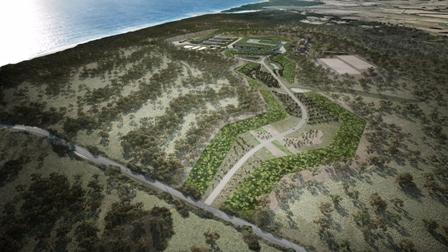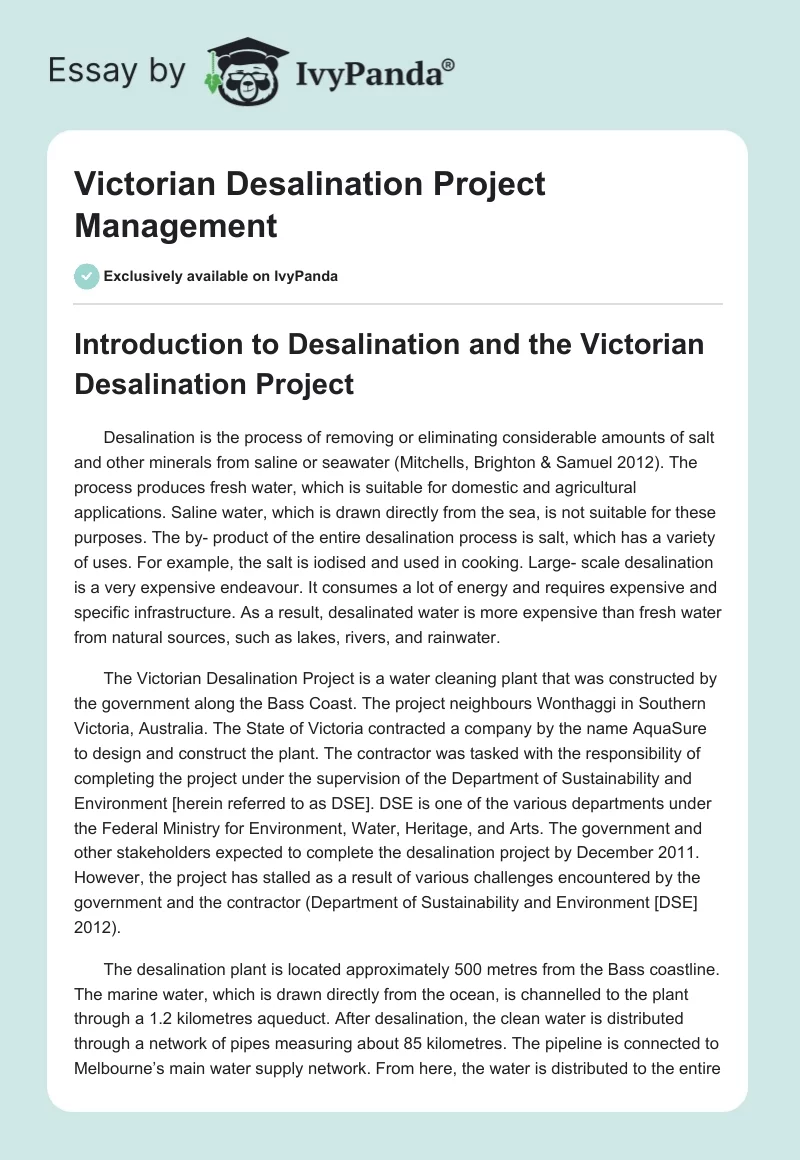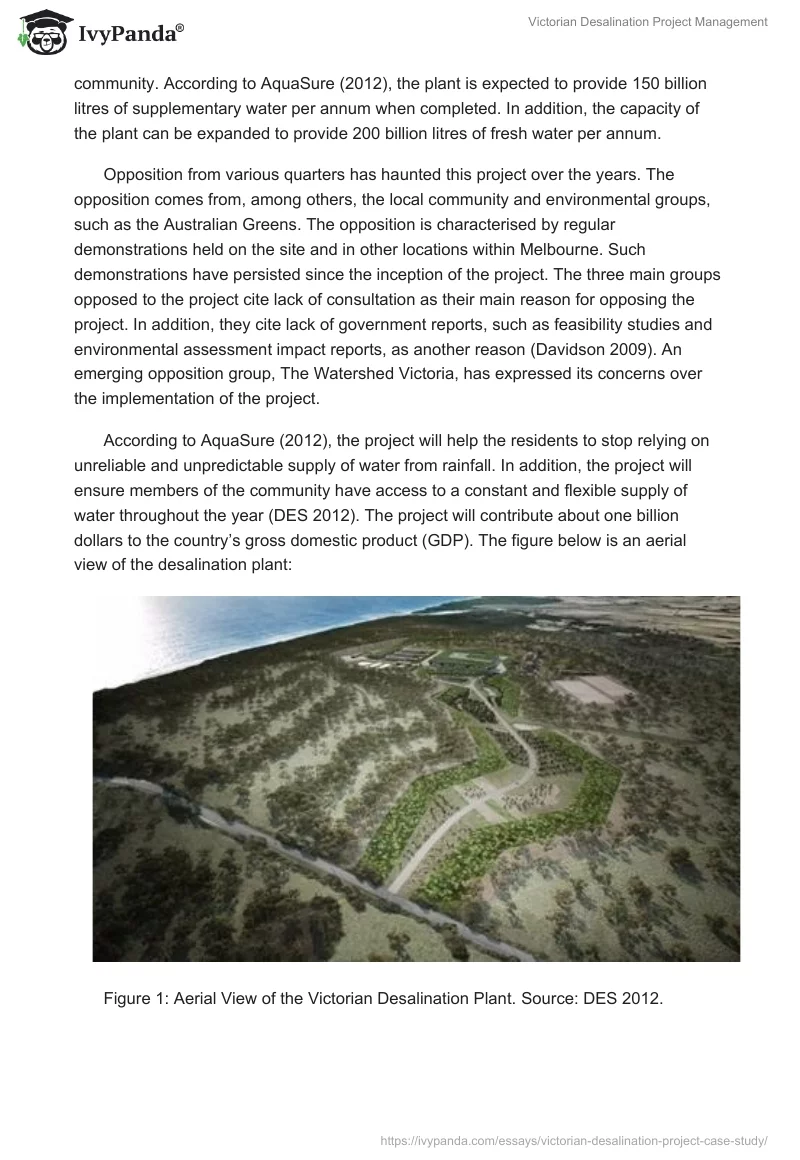Introduction to Desalination and the Victorian Desalination Project
Desalination is the process of removing or eliminating considerable amounts of salt and other minerals from saline or seawater (Mitchells, Brighton & Samuel 2012). The process produces fresh water, which is suitable for domestic and agricultural applications. Saline water, which is drawn directly from the sea, is not suitable for these purposes. The by- product of the entire desalination process is salt, which has a variety of uses. For example, the salt is iodised and used in cooking. Large- scale desalination is a very expensive endeavour. It consumes a lot of energy and requires expensive and specific infrastructure. As a result, desalinated water is more expensive than fresh water from natural sources, such as lakes, rivers, and rainwater.
The Victorian Desalination Project is a water cleaning plant that was constructed by the government along the Bass Coast. The project neighbours Wonthaggi in Southern Victoria, Australia. The State of Victoria contracted a company by the name AquaSure to design and construct the plant. The contractor was tasked with the responsibility of completing the project under the supervision of the Department of Sustainability and Environment [herein referred to as DSE]. DSE is one of the various departments under the Federal Ministry for Environment, Water, Heritage, and Arts. The government and other stakeholders expected to complete the desalination project by December 2011. However, the project has stalled as a result of various challenges encountered by the government and the contractor (Department of Sustainability and Environment [DSE] 2012).
The desalination plant is located approximately 500 metres from the Bass coastline. The marine water, which is drawn directly from the ocean, is channelled to the plant through a 1.2 kilometres aqueduct. After desalination, the clean water is distributed through a network of pipes measuring about 85 kilometres. The pipeline is connected to Melbourne’s main water supply network. From here, the water is distributed to the entire community. According to AquaSure (2012), the plant is expected to provide 150 billion litres of supplementary water per annum when completed. In addition, the capacity of the plant can be expanded to provide 200 billion litres of fresh water per annum.
Opposition from various quarters has haunted this project over the years. The opposition comes from, among others, the local community and environmental groups, such as the Australian Greens. The opposition is characterised by regular demonstrations held on the site and in other locations within Melbourne. Such demonstrations have persisted since the inception of the project. The three main groups opposed to the project cite lack of consultation as their main reason for opposing the project. In addition, they cite lack of government reports, such as feasibility studies and environmental assessment impact reports, as another reason (Davidson 2009). An emerging opposition group, The Watershed Victoria, has expressed its concerns over the implementation of the project.
According to AquaSure (2012), the project will help the residents to stop relying on unreliable and unpredictable supply of water from rainfall. In addition, the project will ensure members of the community have access to a constant and flexible supply of water throughout the year (DES 2012). The project will contribute about one billion dollars to the country’s gross domestic product (GDP). The figure below is an aerial view of the desalination plant:

Scope of the Victorian Desalination Project
The Victorian Desalination Plant aims to become one of the largest water purification plants in Australia. The project is expected to meet one third of Melbourne’s annual water requirement. Such regions as Melbourne and Geelong are expected to benefit from the project. In addition, such regional towns as South Gippsland and Western Port are expected to stop relying heavily on unpredictable and unreliable rainfall water supply. The regions will benefit from the 150 billion litres of water supplied annually through the project.
The project aims to improve the quality of water supply services in Victoria (Mitchells et al. 2012). As earlier mentioned, the project involves an underground network of pipes, which will connect the main plant to the Cardinia water reservoir. The connection will translate to approximately 84 kilometres of piping from the plant to Melbourne’s central water tank.
Just like any other project of this magnitude, the Victorian Water Desalination Project has a number of objectives. Some of the objectives the project wishes to accomplish include achieving commercial acceptance and ensuring that the desalinated water meets international water quality standards. Another objective is to provide a flexible supply of fresh water, which will effectively support the envisaged optimisation of Victoria State Water Supply Scheme. The accomplishment of these objectives will enable the plant to expand in the future and supply the extra 50 billion litres of desalinated water to the state as envisaged (DES 2012).
The desalination project has various overarching environmental objectives. The objectives include, among others, minimising negative impacts on the coastal and marine environment by designing and putting in place appropriate risk management and mitigation measures (Davidson 2009). The envisaged risk management and mitigation measures will help in reducing the adverse effects that the project may have on the environment as a result of the intensive construction activities, noise pollution, as well as discharge and disposal of waste products. According to Davidson (2009), the project will prioritise the protection of coastal utilities and facilities. The project aims at conserving the environment by coming up with recreational facilities in public places, such as the beach.
Victorian Desalination Project: Time Management
Time management is crucial to a project of this magnitude. Just like any other project out there, the Victorian Desalination Project has a timeline that should be adhered to. The timeline guides the management in executing activities needed to complete the project. It specifies the dates when certain rewards are expected from the investment (Pritchett 2002).
According to the project’s outlay, the feasibility study was commissioned in late 2006. The feasibility study was followed by a number of activities, including groundbreaking ceremony, formulation of the Environmental Effects Assessment Report, and formulation of an Environmental Effects Statement. The latter was aimed at making sure that the project meets the requirements of the Environmental Protection and Biodiversity Conservation Act. According to AquaSure (2012), the project, which started on 30th September 2009, will be commissioned by the end of the year. The current contract expires on 2nd October 2039 (Solis 2011).
Timing the project helps in tracking the necessary activities that will be undertaken to achieve the set goals and objectives. The timeline provides deadlines that should be met in implementing the project (Solis 2011). In addition, timing a project will help in monitoring and evaluation to determine whether the project is a success or a failure. Monitoring and evaluation is needed to identify adjustments necessary to enhance the responsiveness of the project to the dynamic environment within which it is operating. In addition to this, a time frame helps in planning for the available resources, which enhances the profitability of the project.
If the timeline is not adhered to, the project will incur huge losses as far as the resources and the capital invested in such a project are concerned. The losses negatively affect the quality of the project, leading to the possible termination of the contract. Termination of the contract and such other developments inconveniences the implementation of the project since investors expect to make profits. The company will be fined as a result of failing to adhere to the timeline.
Communication Management
Due to the ongoing campaigns to oppose the desalination project, the Department of Sustainability and Environment (DSE) has come up with a dedicated desalination project team under the auspices of the Capital Projects Division. The aim of the team is to facilitate and manage the delivery of this project. There are six teams put in place to ensure that all necessary areas of communication are effectively tackled (DSE 2012). The six areas and the six teams are analysed in detail below:
Commercial and Legal Team
The team is charged with the responsibility of tendering and assessing bids. It is responsible for the promotion of public- private partnerships for the project (Solis 2011). In addition, the team has the mandate of representing the project in legal suits brought against it. The team promotes sound management of funds allocated to the project by the federal government.
Property Team
It is another important team in the project. The team handles the consultations and negotiations between the project and various individuals who own the land where the plant is located. It also negotiates with individuals who own the land where the power station is situated and where the pipeline passes through. The team arranges for land acquisition when and where required. The core mandate of this team is to liaise and negotiate with land owners with regard to compensation for the land acquired, as well as deal with temporary construction (Pritchett 2002).
Technical and Engineering Team
The team assists AquaSure in developing the design and construction requirements for the project. The team is tasked with the responsibility of reassessing and re-evaluating design packages to ensure that they adhere to performance requirements as per the project’s terms of reference.
Planning and Environment Team
According to Pritchett (2010), the team obtains and renews various approvals required for the project. The approvals include, among others, the Environment Effects Statement. It is also tasked with the responsibility of developing the performance requirements. The team plays an important role in ensuring that the management team adheres to the various environmental regulations (Mitchells et al. 2012).
Business Services Team
Business services team ensures that the resources and essential policies required for the Victorian Desalination Project are acquired and made available. According to Astorino (2009), this is one of the most important teams since it helps the management to overcome unanticipated changes in the economy, such as an economic recession.
Communications and Stakeholders’ Relations Team
Communications and stakeholders’ relations team, which was established as early as 2007, manages all the public relation affairs touching on the project. It is the team responsible for the dissemination of information to the stakeholders and to the general public. It informs the stakeholders on the progress made in the project.
Integration Management System
Integration management system is described as a form of management system that merges all the systems and processes in the organisation into one cohesive structure. The merging helps the organisation to operate as a unified entity with goals aligned to the strategic plan (Homburg, Sabine & Harley 2009). As a result of a unified objective, which is in line with the strategic plan, the management of the project is greatly improved. Astorino (2009) explains that an integrated management system allows a team of managers to create one framework, helping the organisation to effectively and efficiently realise its goals.
The management team at Victorian Desalination Project has adopted integration management system to handle the project. Cooperation between the Department of Sustainability and Environment and AquaSure consortium is evident. The consortium is tasked with the responsibility of designing and constructing the plant. The cooperation and adoption of the management system has enhanced the success of the project. As a result of this form of management, the project successfully supplies high quality fresh water, which is derived from seawater (Mitchells et al. 2012).
Cost Management
Various measures are put in place to reduce the costs of managing the project. The measures include the splitting of ownership of the project. Important to note is the fact that AquaSure is contracted by the Victorian state government to finance the project, which includes designing, constructing, and commissioning the desalination plant (Homburg et al. 2009). The company is supposed to operate, maintain, and repair all desalination systems, including the pipeline. The operation will continue until the 30 years’ contract expires.
Investors in AquaSure include Degremont, Thiess and Thiess Services, and Macquarie Capital. The different companies specialise in water desalination technology, engineering and civil contracting, and financial advisory. In an effort to manage the cost of running the plant, AquaSure subcontracted D&C and Thiess Degre’mont to design and construct the desalination plant. Thiess holds 65% of the shares in the joint venture while Degre’mont holds the remaining 35%. The joint venture is established on the basis of fixed time and fixed contract price (INSEAD 2010).
O&M contractor is another joint venture between Degre’mont and Thiess. Degremont holds 60% of the shares in the joint venture, while the remaining 40% is held by Thiess. O&M contractor is charged with the responsibility of operating and maintaining the pipeline system. The aim is to ensure that the pipeline delivers a specified volume of desalinated water. AGL Energy Ltd. was subcontracted to supply energy for the project at a fixed price for a period of 30 years. AGL is mandated to fully meet the project’s energy requirements by supplying renewable energy (Davidson 2009).
Risk Management
The company faces a lot of risks considering that it is dealing with marine water. A small mistake in handling this water can endanger the entire aquatic ecosystem. As a result, AquaSure has adopted an environmental monitoring schedule. Some of the core priorities of the project include minimising the adverse effects the project may have on the environment. The project complies with the provisions of the Discharge License and the Pollution of Waters by Oil and Noxious Substances Act of 1986 (Mitchell et al. 2012).
According to AquaSure (2012), detecting the acidity of ground water on time enables the company to minimise the risks of water pollution (Mitchells et al. 2012). Measures are put in place to ensure that the animals and plants in the area are not adversely affected by the operations of the facility. As far as leakages from the plant are concerned, detectors are strategically placed to enable the emergency team to respond on time if such incidences occur (Solis 2011).
The company uses ‘the discounting rate’ to determine whether the risks are transferable or not. The rate is based on the assumption that projects possess systematic risks, which are borne by the public sector, the private sector, or both. Therefore, diversifiable risks are not taken into account (INSEAD 2010). Systematic risks are transferred from the government to the private sector with the use of Capital Asset Pricing Model. The model is used to determine the transferable risks (INSEAD 2010). O&M and D&C contractors are insured by their parent companies.
Procurement Process
The process of acquiring goods and services needed for the completion of Victorian Desalination Plant is structured in such a way that quality and quantity needs are met. In addition, the procurement process promotes open and fair competition. The procurement process helped the company to win the Engineering and Process Equipment Procurement Award (Project Management Institute 2012).
Challenges Facing the Implementation of the Victorian Desalination Project
The project has faced various challenges arising from its area of operation. One of the major challenges is the high cost of raw materials. The high cost is the reason why the Victorian government contracted other companies to undertake the project. As a result of the high costs of raw materials used, desalinated water is very expensive. The cost of the raw materials has escalated as a result of the recent global recession.
The project has encountered several delays. The delays are brought about by industrial actions taken against the company as people agitate for the dismissal of some of the top managers in the contracted companies. The project was completed on 30th June 2012, and not on December 2011 as envisaged, due to these industrial actions. As a result, the company is penalised A$1.8 for each day that water is not delivered.
Another challenge that the project has faced includes hostility from the entire Melbourne community. Activists sued AquaSure Consortium for various reasons, including, among others, alleged interference with marine life. Such cases forced the company to spend a lot of money and time fighting unending court battles. Apart from the community, some politicians are opposed to the project. They have derogatorily termed it as ‘a white elephant’ (Davidson 2009).
Conclusion
In spite of the various challenges, the company has efficiently and transparently managed the project. There were various delays in completing the project due to industrial actions and court orders against the company. In addition, the high cost of raw materials has adversely affected implementation of the project. The high number of certifications required for the project is another challenge.
The above challenges notwithstanding, the project is regarded by many analysts as a great success. In the future, the project may be emulated all over Australia to reduce overreliance on natural water. Many families are now enjoying uninterrupted supply of fresh water, which was not the case in the past.
References
AquaSure 2012, Victorian Desalination Plant, Web.
Astorino, D 2009, ‘Five roadblocks to successful acquisition integration’, Executive Insights, vol. 24, no. 2, p. 54.
Davidson, K 2009, ‘Water policy delivers scary possibilities’, The Age, vol. 56 no. 2, p. 13.
Department of Sustainability and Environment 2012, Victoria Desalination Project, Web.
Homburg, C Sabine, K & Harley, K 2009, Integrated management: a contemporary perspective, Free Press, London.
INSEAD 2010, Project finance: Victorian Desalination Plant, Web.
Mitchells, K Brighton, G & Samue, W 2012, ‘Report of the inquiry to the minister for planning – Victorian Desalination Project – environment effects statement’, The Age, vol. 56 no. 2, pp. 45-48.
Pritchett, P 2002, Shaping corporate culture: the mission critical approach to cultural integration and culture change, McGraw Hill, London.
Pritchett, P 2010, Smart moves: a crash course on merger integration management, McGraw Hill, London.
Project Management Institute 2012, A guide to the project management body of knowledge (PMBOK guide), 2nd edn, Paperback, Melbourne.
Solis, B 2011, The success of Victorian Desalination Project, John Wiley & Sons Inc., London.


